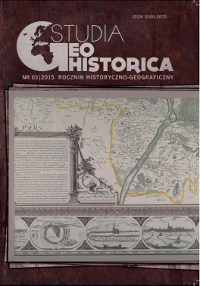Miasto późnośredniowieczne i nowożytne na przykładzie „Atlasu historycznego miast polskich – Gdańsk”
A Late Medieval and Early Modern Town: the Case of “Historical Atlas of Polish Towns – Gdańsk”
Author(s): Zofia MaciakowskaSubject(s): Historical Geography, Maps / Cartography, Middle Ages
Published by: Polskie Towarzystwo Historyczne
Keywords: atlas historyczny miast polskich;rozwój przestrzenny;średniowiecze;działka;miasto;socjotopografia;historical atlas of Polish towns;spatial development;Middle Ages;a plot of land;town;sociotopogra
Summary/Abstract: In the present article the author attempted to present the problems experienced while working on the changing city topography. Th ese are the reflections the sources of which were the studies conducted in the course of preparing a historical atlas of Gdańsk (supervised by Professor Doctor Habilitated Wiesław Długokęcki, University of Gdańsk). Results of the research are above all connected with the state of research (source studies, archeological and architectural studies) and the maintenance of sources. When these are insufficient, it frequently turns out that an unambiguous presentation of the spatial development is not possible. One of the basic sources to analyze the changes in the urban arrangement and to attempt to recreate the city subdivision in the medieval period are the archival maps and plans. Transferring selected information on the board of the city development requires a detailed analysis and an individual approach. Considerable problems are connected with recreating the city fortifications and their forms which are not preserved or which were preserved only partially at the moment when the oldest cadastral plan was prepared, the basis of most boards. However, the most difficult element of research on the space of a medieval or modern town is certainly an attempt at correlating the written sources with a specific place in its space – with a specific estate. This requires reconstruction of the town subdivision, which – with a lack of proper archeological or architectural studies – is not possible. Some researchers who deal with the analysis of transformations of the urban space make use of the method of metrological analysis, which was particularly popular in the 1960’s and the 1970’s and according to which medieval towns were measured in accordance with the modular plan. Results of research conducted for the New Town in Gdańsk question the application of this method separately from the sources unambiguously determining the medieval subdivision. In case of no such sources any attempts to ascribe the source information to concrete plots are only hypothetical. Similar difficulties also occur while establishing the localization of markets, trading and industrial places – besides those that are generally well-known. Many of them have not survived till modern times and that is the reason why they cannot be found on the oldest plans. Th e graphic presentation of the localization of those and other places or areas and their borders requires considerable discipline from researchers which does not have to be so rigorously observed in the verbal description of the space. An interesting observation made while transferring the source materials to the city plan was that at the beginning of the 19th c. a number of streets or their fragments both in the Main and the Old Town in Gdańsk were still settled by representatives of one guild, like it was in the Middle Ages. Both towns had different character, which resulted from the settlement of different professional groups in their areas.
Journal: Studia Geohistorica
- Issue Year: 2015
- Issue No: 3
- Page Range: 219-235
- Page Count: 17
- Language: Polish

